Mike Vardy's Blog, page 61
April 20, 2017
Why You Should Play Productivity “Small Ball”

During the early part of 2017, I hosted (or co-hosted) a webinar of some sort every week. This wasn’t initially planned. It just happened to take shape. I knew I wanted to do more video work in the months ahead, but I didn’t expect things to start out like that.
But it did.
So I decided to keep at it by playing productivity “small ball.”
Small ball is a baseball term used when a team focuses on placing runners on base through a few extra base hits with the plan to deliberately move the runners into scoring position. The speed of the runners plays a huge role, as do walked batters. It’s a methodical way of playing the game in order to manufacture runs with less powerful hitting involved.
Instead of going for the home run with a big marketing push on video, I just tacked it on to my workflow. I wasn’t swinging for the fences with it. I was just getting on base and trying to get some runs in to see what would happen.
I’m hosting a FREE webinar on Friday April 21st at 3pm ET/12pm PT that will help those of you who want to leave Wunderlist behind and migrate into a suitable replacement. Microsoft is slowly transitioning the popular to do list application into To-Do and while Wunderlist will be around for a little while longer, I want to help you be proactive with moving away from it. You can click here to register for “How to Walk Away from Wunderlist (and Never Look Back)” now.
You don’t need to play small ball with everything, and you don’t need to do it with a project or outlet like I do. Instead, you could do it by adding a mini-habit to your daily routine. You could optimize your email workflow through creating different signatures. Small ball works really well for some things and can even help build momentum towards bigger things.
If you’ve read my Year in Preview piece for 2017, then you know that I map out my months by theme – and you even know how each of my months has been themed. The way I can live up to those themes is by working towards small, measurable gains over the entire month. Sometimes I am able to make great strides with a Monthly Theme, but there’s no guarantee that will (or can) happen. That’s why playing small ball makes sense. It allows me to make incremental progress almost every single day.
Playing small ball also allows you to stay focused because it is very detail-oriented. It breaks things down – such as goals and projects – to the smallest of tasks. Each task you complete for a project gets you that much closer to finishing the project. Small ball may give you more tasks to complete (or more instances of a task to complete), but it keeps you moving things forward…even in a small way.
Small ball may not be as glamourous as a home run, but the chances of achieving forward progress are far greater. Why? Because the tasks are easier to work with and to complete.
So swing for the fences every once in awhile, but more often than not you should strive for making contact instead. Then you can touch all the bases deliberately…and more often.
And that’s how you win the game.
The post Why You Should Play Productivity “Small Ball” appeared first on Productivityist.
April 17, 2017
Making and Modifying with Justin Jackson
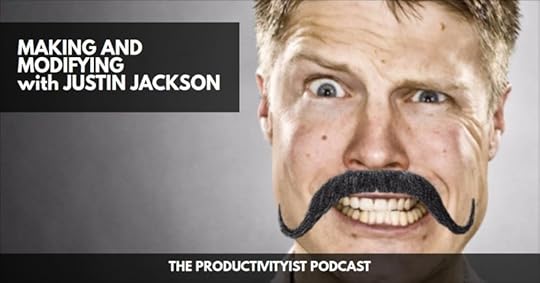
My guest this week is Justin Jackson. He is a dad, husband, entrepreneur, coach, the founder of Megamaker, author of Jolt, the creator of Marketing for Developers and Tiny Marketing Wins, and overall serial maker. He aims to help people through the things they create.
On this episode, we discussed the processes of making and/or modifying. We delved on his systems and approaches in the different initiatives and creations he is currently working on.
Other areas we touched on includes:
The story of how we met, a brief background of how he has always been involved in businesses and how he transitioned from non-profit, to consultancy, and finally – going solo with his independent projects (1:30).
How getting married, having children and experiencing failure, affected his plans and initiatives (5:25).
The process of starting up independently, which includes conceptualizing, case studies, exploring and being a serial maker – getting involved in different things which include his podcast, softwares, plugins, e-books, courses, and even merch (7:32).
How and why he decided to zero-in on writing Jolt and finishing it in the span of a month (8:43).
The concept of mind gremlins, how being less self-serving enabled him get rid of these, and other takeaways that people have from his two top products – Jolt and Marketing for Developers (12:00).
Conducting a survey and how its findings gave him insights when he created Tiny Marketing Wins (15:10).
His process when things must be put on the backburner or let go, and how he did this with his podcast (17:49).
His hybrid approach when it comes to making, modifying and refreshing the systems, tricks, and hacks supported by continuous research and learning (19:55; 23:44).
A sample hack he shared in writing effective landing page copy and generating leads (22:20).
If you want to hear more from Justin, check out this bonus episode where we had some deep-dive on learning and the idea of Brutalism.
Relevant Links:
Justin Jackson | Make some stuff
MegaMaker
What has Justin made? | by @mijustin
Jolt | Sell more by standing out
Marketing for Developers | A guide to marketing your software, apps, and digital products
Tiny Marketing Wins | Weekly marketing tactics for online businesses
Watch for mind gremlins | by @mijustin
Focus on your own shit | by @mijustin
Learning with Justin Jackson | Productivityist
We all want progress | by @mijustin
Justin Jackson | YouTube
Justin Jackson (@mijustin) | Twitter
Thanks for listening, until next time remember to stop guessing… and start going.
If you’re interested in supporting the podcast and receiving exclusive content while doing so, you’ll want to check out the patrons-only version of The Productivityist Podcast on Patreon. Also, remember to leave The Productivityist Podcast a rating and review on iTunes, or on whatever platform you’re listening to. I read every single bit of feedback we receive. I want to make this show better and with your help I can do just that.
The post Making and Modifying with Justin Jackson appeared first on Productivityist.
April 13, 2017
The Importance Of Taking Part In Non-Tech Related Hobbies And Activities
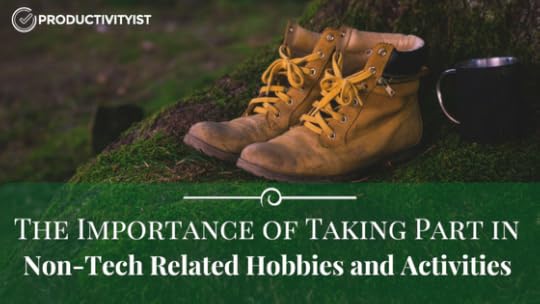
Today’s guest post is by Kacey Mya. Kacey is a lifestyle blogger for “The Drifter Collective.” She finds excitement in the world around her and this is portrayed through her visually pleasing, culturally embracing and inspiring posts. You can connect with Kacey on Twitter, Pinterest or Instagram.
Today it seems most forms of entertainment involve turning on a screen and staring at it for hours at a time. However, when you make time for hobbies and activities that don’t involve technology, it can be really beneficial for your health and happiness. And when you’re happier and healthier, you’re also more productive.
It may feel a little odd to turn off all of your screens and instead read a book or take a walk, but these activities can and will actually make you a more relaxed and content person overall. Here’s why doing something non-tech related is so important and some ideas to get started.
Lower Your Stress Levels
Nobody is shocked to learn that all of the technology around us makes us more stressed. It only makes sense. Smartphones and tablets make us reachable by anyone at anytime and anywhere. Days off from work no longer mean days off from work. You’ll probably still receive phone calls and emails that you’ll be expected to answer, so a day off from work really means working from somewhere else.
Friends and family expect you to answer your phone when they need something. No matter where you go or what you do, you can be bothered by somebody else who needs you to do something for them. There’s no such thing as “me time.” Unless you turn off your devices.
When you turn off your phone, nobody can reach you. They’ll try, but you won’t be around to answer them. Sometimes this is a really good thing. Unplugging like this lifts a weight off your shoulders that you might not even know is there. You’ll be able to do something for yourself without constantly waiting for a buzz from your phone and looking at your screen.
While you might enjoy playing games on your phone, watching shows or browsing through social media, taking some time to turn off your phone and step away is so beneficial. So, when you feel like browsing on your phone, put it away. Pick up a book. If it’s nice out, take a walk outside. Grab a friend and go to dinner, no phones allowed. This may be scary the first time you try it, but you’ll love the feeling you get when you don’t have to be attached to your technology.
Bond with Others
Sure, social media and texting helps people stay in touch who may otherwise never speak to each other. But sometimes, it’s better to actually talk face-to-face with friends and loved ones instead of messaging them or liking their posts.
There are many activities that do not involve technology at all. For instance, get a group of friends together to participate in a community event. Most neighborhoods and towns have a lot of events that are open to the public that people just don’t know about.
Find your local community’s website or social media page to find out about the various events you can attend. Then choose one and go! You’ll meet new people who live in your area, and you’ll participate in something fun instead of just watching Netflix. Many communities even have clean-up events, food and clothing drives and other volunteer opportunities that can build your resume and make you feel great.
Expand Your Horizons
TV shows, movies and social media pages do sometimes offer interesting viewpoints on current events, but there’s nothing like getting out there and trying something out instead of watching it or reading about it.
Instead of reading about local politics, attend the next town meeting. Instead of watching videos of other people making delicious food, get out a cookbook and make something yourself. Try a new craft or host a craft night with your friends.
Visit a museum and learn something new. That may even start a new hobby, like collecting stamps. More than five million people collect stamps in the United States, and there are specific museums all around the world just displaying stamps. There are all kinds of interesting niche hobbies that might just catch your attention and introduce you to a whole new world.
Give yourself a break from the constant hustle and bustle. I’m willing to bet you’ll find you are more fulfilled and even more productive.
Do you have any non-tech related hobbies? If so, please share in the comments. (If you don’t, what is a non-tech related hobby you’d like to try?)
The post The Importance Of Taking Part In Non-Tech Related Hobbies And Activities appeared first on Productivityist.
April 11, 2017
Why I’m Tired of the Word “Hustle” (And Use This Word Instead)
Certain buzzwords out there that have grown in popularity, and “hustle” is one of them. I’m not a fan of what it’s become.
It’s not the first term that I’ve tired of; “Inbox Zero” is another that immediately comes to mind. When the term was coined by Merlin Mann years ago, it didn’t mean getting your email inbox to zero messages. Rather, Merlin meant that the zero represented “the amount of time an employee’s brain is in [his/her] inbox.”
What does that mean? It means taking what is currently known in your inbox and knowing what it represents. It does not mean constantly living in your email inbox so that by day’s end there’s nothing left in there. That kind of activity can (and often does) result in other work – deeper work – not getting done.
The word “hustle” has started to grate on me as well, much in the same way “Inbox Zero” has.
Why?
Because it infers that you need to keep moving. Relentlessly. Without stopping.
I see plenty of people embodying the “hustle” mindset when they attack their to do lists. They go in and try to check off as many boxes as possible, doing so as quickly as they can. The problem with that is you can spend time checking off boxes that aren’t ones that need to be checked off. When you’re always hustling, you run the risk of not slowing down to strategize. You don’t step back long enough to gain perspective. (In fact, stepping back can appear to be a step in the wrong direction.)
Sure, there are plenty of people who hustle and still pause and reflect. Or at the very least they chronicle their days so they can review them at their leisure. That’s one way around it.
But not everyone can (or wants to) do that.
You also can’t “hustle” your way to true personal productivity. You need to focus on your intentions and then have a means to pay attention to them consistently, so you make forward progress with them. Sometimes – and I know this is cliché – it’s slow and steady that wins the race.
Keep in mind I’m not talking about “side hustle” here. That’s a term unto itself. It’s also a noun. I’m talking about the verb.
Also, keep in mind that the other definition of hustle is to con or swindle. I know it might be a stretch to say that when you try to “hustle” your way to success or to peak personal productivity, you wind up conning or swindling yourself because it’s not sustainable.
It might be a stretch to suggest that, but I’m going to share that thought anyways.
Jeff Goins agrees with my stance on the word as well. Here’s one of his comments on this Facebook discussion thread he started:
“If you rush the work, you can do more harm than good. That’s the problem with hustle. So let’s take our time and move with intention.”
While Jeff goes on to say in that thread he prefers the term “perseverance,” I’d like to propose an alternative. Rather than focus on hustle, focus on being lively.
Hustle is about doing. But “lively” is about being. I’ve often said we should stop “doing” productive and start “being” productive. I say we should be lively in everything we do instead of focusing on the hustle mindset.
The definition of “lively” I’m going for here is as follows: full of life and energy; active and outgoing.
I believe that if you approach your life and your work in a lively manner, then you’ll receive all the benefits of the hustle mindset but you’ll have a greater chance of lining it up with what you really want to be doing with your life.
I’m just beginning to explore this idea (first touching on it during my Think Better Live Better talk in Florida), and I’d love to hear your thoughts on it as well. You can do so in the comments below or share it on social media and tag me in the conversation.
The post Why I’m Tired of the Word “Hustle” (And Use This Word Instead) appeared first on Productivityist.
April 10, 2017
The Productivityist Podcast: Building an Empire with Stacy Tuschl
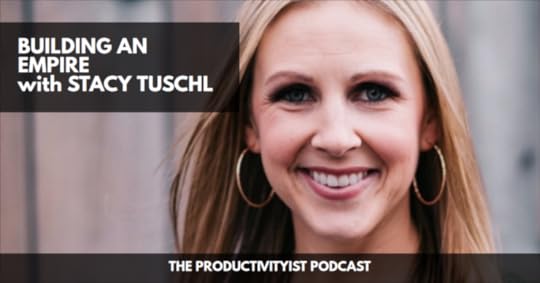
For this episode, my guest is Stacy Tuschl of She’s Building Her Empire. Stacy is a business owner, philanthropist, in-demand speaker and business coach, author, wife, and mother. Her book Is Your Business Worth Saving? is a #1 International Bestseller which helps entrepreneurs to move towards success and do so without sacrificing time away from family.
She started her first business at age 18 in her parents’ backyard and was able to grow it into a 7-figure business. As an entrepreneur herself, she understands what her clients experience and struggle with – her hands-on experience and realistic approach ensures that women achieve their business goals.
Rescuing businesses and building empires are just some of what we’ve discussed. Other topics we’ve chatted about are:
How her journey as an entrepreneur started, how coaches and mentors helped her in her business early on and how she realized her niche in the business (1:58).
How meeting people with the same mentor yet in different phases and success levels of their businesses motivated her to write her book (4:00).
Her reason to niche down and focus on women entrepreneurs with She’s Building Her Empire (5:25).
Lessons learned, challenges her team faced and the groundwork involved with rebranding and shifting focus (8:04).
The diverse stories of the guests in her show and why she decided despite being a female-oriented brand to have male guests on her podcast (11:41).
Family and parenthood’s impact on her business, how her calendar, chunking, and theming the days enables her to accomplish more, and similar productivity systems I practice (14:51).
How people can start to emulate Stacy’s systems through proactive and reactive work scheduling, and having a top 3 in the to-do list (20:48).
The Mompreneur money map, how it works by simplifying things and implementing ideas, and how to get a free copy of it (21:50).
Her advice to people waiting to launch their business ideas but lacks the confidence to do so (24:20).
Relevant Links:
She’s Building Her Empire | Stacy Tuschl
Is Your Business Worth Saving by Stacy Tuschl
Episode 140: How to Know When It’s Time to Rebrand | Stacy Tuschl
Mompreneurs Money Map
She’s Building Her Empire | Facebook
The Power of Chunking | Tony Robbins
She’s Building Her Empire Live
Meet Stacy | Stacy Tuschl
Stacy Tuschl (@StacyTuschl) | Twitter
Thanks for listening, until next time remember to stop guessing… and start going.
If you’re interested in supporting the podcast and receiving exclusive content while doing so, you’ll want to check out the patrons-only version of The Productivityist Podcast on Patreon. Also, remember to leave The Productivityist Podcast a rating and review on iTunes, or on whatever platform you’re listening to. I read every single bit of feedback we receive. I want to make this show better and with your help I can do just that.
The post The Productivityist Podcast: Building an Empire with Stacy Tuschl appeared first on Productivityist.
April 6, 2017
How I Screwed Up My Monthly Theme (And Why I’m Glad It Happened)

For the first time in years, I screwed up my monthly theme. But the outcome is going to be worth it.
Let me explain.
I recently went on a three-week journey in the Philippines. I saw some amazing scenery, took in as much of the beautiful country as I could, and spent time with incredible people. This trip took up 23 days of the month. With it in the rearview mirror now, I realize that I should have left this month “themeless” instead of giving it the overarching focus of “Relationships.”
You see, while I spent part of the trip working on relationships, I didn’t give it my overarching focus. At least not all of my relationships. Instead, I focused on a scant few – and one in particular.
This month was pretty much all about connecting deeper with my wife, Anne.
We’d spent almost every moment over those three weeks together. Many of those moments were expected, but some were not.
Anne embraced the event we were at in Cebu. She was a shining star at Tropical Think Tank, making friends with entrepreneurs in a way I’d never seen before. She’s never really gone to any of the events I’ve spoken at (or attended), so I didn’t know what to expect. If anything, I thought she’d steer clear of everyone and sunbathe most of the time. That was not the case at all.
I have a deeper respect for my wife than when we started on this journey. There was an aspect of me who felt as if she didn’t “get me” with the work that I do. I couldn’t have been more wrong. I learned a lot by spending all of that time with her.
The best part? I want to spend even more time with her now.
But that wasn’t why I screwed up my monthly theme. Clearly, I focused on only one relationship, but there was a greater lesson in choosing this month’s theme and not living up to its demands.
Relationships deserve far more than just one month of overarching focus. Relationships deserve focus every single day.
Sure, you can’t be expected to foster every relationship every day, but you can reach out and foster them on an ongoing basis. Whether it’s your family, your friends, your customers, or other relationships in your life, you can (and should) focus on relationship every day because ultimately they are what matter in life.
In fact, that was my greatest takeaway from Tropical Think Tank.
I’m going to make a conscious effort to redesign, rebuild, and reclaim relationships going forward. This goes for everyone in my life – those close to me and those who I’ve barely crossed paths with before. If you’ve emailed me, I’ll email you back (and sooner than before). If you’ve asked me to do something, I’m going to take my deliverables up a notch (or several). If you want my help, just ask. I’ll be there to lend it.
I don’t consider this month to be a failure. I consider it to be a teaching moment. And I’m going to learn from it.
The post How I Screwed Up My Monthly Theme (And Why I’m Glad It Happened) appeared first on Productivityist.
April 4, 2017
The Difference Between Comfort, Cockiness, And Confidence

As I laid down on a rock using my legs as a brace to keep me from falling into the cold rushing water, I thought to myself, “I can’t believe I made it here.”
“Here” was the Hapao Hot Spring. It also features some cool rapids adjacent to the spring so you can go from a warm bath to frigid water (or vice versa) in just a few steps. My wife and I had hired a local guide to take us through the Hapao and Hungduan Rice Terraces with a stop at this waterway two-thirds of the way through our journey.
But I almost didn’t make it to the water. I felt as if I was going to fall off of the thin walkways as we traversed our way along the terraces.
You see, I’m not much of an outdoorsmen. Some might even call me clumsy. (I’d agree with them.) But I wanted to experience this area of the Philippines because it was touted as a man-made wonder of the world. So I stepped outside of my comfort zone, and I took on the persona of a hiker.
As I walked along the terrace boundaries – some wider than most – I felt unsure about my footing. I slowed my pace, struggling to keep up with my wife and the guide. Whether that was because I was inexperienced or because the paths were not designed for feet my size wasn’t the point. The point was that I was not confident with my steps, so I was careful with them.
Then I started to get more comfortable.
I took longer strides. I picked up the pace. I felt more confident with each step I took. Even as the path narrowed and the incline became steeper, my confidence grew.
That’s when I lost my footing.
No one in front of me saw me stumble. Both the guide and Anne were several steps ahead of me when I stepped a little too far to the right and almost wound up face first in a rice terrace about a foot below. (Had I listed left I wouldn’t have just landed in a rice terrace. I would have plummeted several feet into one.)
I caught myself and steadied my stance. I took a deep breath and slowly resumed walking. A few strides later, the path widened. I caught up with the rest of my party, none of whom had a clue what almost went down (namely, me).
As I kept walking, I began to think about the difference between being comfortable, confident, and cocky.
When I started the trip, I was comfortable at my own pace. I didn’t worry about what the others were doing. I went on my own way. But as the distance between us grew, I knew I needed to pick up the pace. Because I’d been doing so well to that point, I felt more confident. Initially, I was able to keep up. The distance disappeared, and I was right behind them. I felt really good about where I was at, and I figured could push it further.
That’s when I got cocky. And that’s when I almost wound up in the mud.
You don’t need to be walking along a rice terrace in the Philippines for this to happen.
For example, take a look at your to do list. Here’s a breakdown of what comfort, confidence, and cockiness can do to it.
Comfort
A to do list that makes you comfortable will only take you so far. You’ll feel good with it to a point. But eventually, you’ll feel you can be doing more. A to do list that is filled with things you need to do and little of what you want to do is one that can lead you down this path.
You’re comfortable in knowing you can deal with those things that need doing, but when that happens over an extended period of time, you spend more time being reactive than proactive. There are times you need to comfortable with your to do list (when you’re taking on a new project or job, for example). But at some point, you’ll need to dig deeper and push further ahead.
Confidence
When you get to a point when your to do list serves you well beyond the current day, you’re going to gain confidence with it. Confidence in your to do list is often accompanied with the knowledge that you have a solid system in place that will help you accomplish what’s on it. You’ve got a nice balance going between what is urgent and what is important, with a bias towards the latter. There’s little to no friction when you start and end your day when you are confident in your to do list.
Eventually, that confidence starts to spread beyond the day. Your weeks seem to be more in order. Your months map out in a way that they haven’t before. Everything is falling in line, and you feel as if nothing can halt your forward progress.
Cockiness
Cockiness can set in when you get too confident in your to do list. There are things that come up out of nowhere that can really throw you. This WILL happen. Anyone who says it doesn’t is not being completely honest about it. Life is unpredictable. Despite every effort you make to have a framework or process in place to deal with what life throw at you, there will always be curveballs that throw you off your game. These are important, though, because they are the things that will humble you (and your to do list).
Getting comfortable is the first step. Comfort is the building block for what’s to come – confidence.
Being confident is important because it’s how you take things to the next level. Confidence breeds confidence in no matter what you do. In fact, you’ll go back and forth between comfort and confidence as you advance.
(If you’re saying to yourself “Oh, yeah. This is going to be a breeze.” then I really want to you think about it harder. That kind of inner dialogue might just be cockiness trying to break through.)
You want to avoid cockiness as much as possible. It’s the thing that can derail you. It’s the thing that can hurt you. It can be the difference between pushing forward and plummeting downwards.
So take a look at the to do list you have right now. Are you feeling good about it? Is it balanced with what you need and want to do? Do you have more on it than you can handle? Give it an honest assessment and decide whether it pushes too far into the realm of cockiness than it should.
The post The Difference Between Comfort, Cockiness, And Confidence appeared first on Productivityist.
April 3, 2017
The Productivityist Podcast: The Staying Power of Sketchnotes with Deborah LeFrank
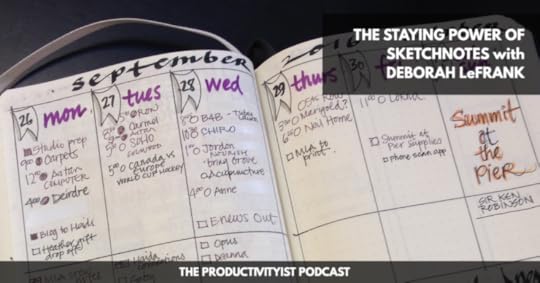 A landscape architect, entrepreneur, graphic journalist and memory collector, Deborah LeFrank uses pens and paper to capture stories from daily life by creating sketch-notes or visual stories which help her remember things and memories. I’ve known her for quite some time and I’m a big fan of her work, and she’s my guest for this episode.
A landscape architect, entrepreneur, graphic journalist and memory collector, Deborah LeFrank uses pens and paper to capture stories from daily life by creating sketch-notes or visual stories which help her remember things and memories. I’ve known her for quite some time and I’m a big fan of her work, and she’s my guest for this episode.She uses bullet journaling and incorporates visuals to it as a key tool for productivity in all aspects of her life. Her company Visual Life Stories helps people to collect their memories through visual stories.
There’s so much that Deborah shared, some of the things discussed are:
How we met at Social Media Camp and the story behind the business cards she handed that really impressed me (1:59; 4:50).
The scope of her work that allows for remarkable presentations and excellent ways to recall and capture the essence of the presentations for the audience (3:27; 7:05).
People’s innate attraction to visual learning and story-telling, and her technique to do the process of note-taking and sketching effectively (8:00).
How she started interest in her craft, honing it through practice as needed in her career (14:20), and finding out about the concept of sketch-notes (16:00).
Integrating analog and digital methods in sketch-noting to create projects and serve clients (18:52).
How bullet journaling allows her to combine artistry and productivity, and how its convenience and flexibility helps her greatly (22:52; 28:06).
Features she’s added into the newest version of her bullet journal like habit tracking template, daily theming and focus words (25:30).
Relevant Links:
Visual Life Stories | Deborah LeFrank
Mike Rohde’s Books on Sketchnoting | Designer Mike Rohde
Eva-Lotta Lamm | User Experience Designer
My 3 Words for 2017 | Chris Brogan
3words | C.C. Chapman
Graphic Recording and Meeting Facilitation with Sunni Brown
Deborah LeFrank (@DeborahLeFrank) | Twitter
Visual Life Stories (@visuallifestory) | Twitter
Visual Life Stories | Facebook
Thanks for listening, until next time remember to stop guessing… and start going.
If you’re interested in supporting the podcast and receiving exclusive content while doing so, you’ll want to check out the patrons-only version of The Productivityist Podcast on Patreon. Also, remember to leave The Productivityist Podcast a rating and review on iTunes, or on whatever platform you’re listening to. I read every single bit of feedback we receive. I want to make this show better and with your help I can do just that.
The post The Productivityist Podcast: The Staying Power of Sketchnotes with Deborah LeFrank appeared first on Productivityist.
March 30, 2017
The Art And Ritual of Productivity
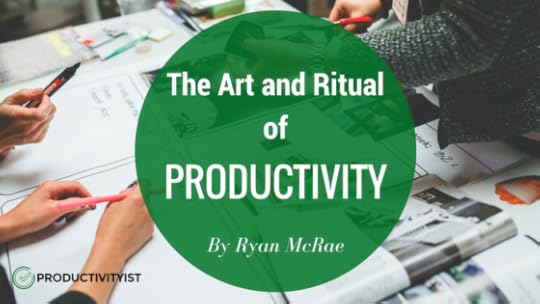
Today’s guest post is by the awesome Ryan McRae. Ryan is the founder of The ADHD Nerd, a blog dedicated to helping people with ADHD be more productive, focused and happy. He is an Apple fanatic, voracious reader, and lover of things pumpkin flavored. He can be reached at theadhdnerd@gmail.com.
When we hear the word “ritual,” a feeling of boring routine is conjured (if not some kind of spooky scene in a horror movie). But I think ritual gets a bad reputation. When it comes to productivity, having a ritual can act as a trigger in our brains and help get us into a state of flow faster.
The purpose of ritual is to simply reduce decision fatigue.
Decision fatigue occurs when we have made too many decisions, and our willpower is depleted. When our willpower is gone, we have less reserve to doing creative things—writing, making music, or cooking new dishes.
If we make our creative process more of a ritual, if we do the same things every day when we are attempting to be creative, we are more likely to have more willpower and thus more focus to do more creative work. Reduce decisions. Increase creative work. Here’s how I do it.
Same Place
I write in the same place every day. I head to the same coffeehouse and do my best to sit in the very same seat. By doing this, I don’t have to decide where to go or check reviews.
Same Music
I listen to the Arrival soundtrack when I write. Every time I cue it up, I am in front of my keyboard ready to go. I don’t listen to anything else because I want my brain to know—this is writing time. It’s an auditory signal that fires me up to write. It’s mellow music, but it changes. More importantly, it has the power to wash away the terrible coffeehouse music I endure.
Same Drink
I don’t want to try something else. I have the drink I love that is chock full of caffeine and get to writing. I don’t get anything with sugar because I don’t want to crash.
Clear My Mind
Having severe ADHD, clearing my mind is like getting all the sand out of my shoes. It takes some effort—but here’s how I do it. Before I write, I simply jot down everything that is crowding my mind. Do I need to pick up detergent? Do I have to pick my up my laundry? Did I pay my electric bill? I jot all of that down in a notebook beside me. I don’t type it because I don’t want my brain to think that my “to do” list is my creative process. I keep that very separate.
Set a Timer
I don’t want to burn out, so I simply set a timer and an alarm. The alarm is for when I’m done writing for the day. This way my brain knows there’s an endpoint to my writing. I set the timer for 50 minutes. After 50 minutes of writing, I just take a break, stand up, stretch, and get back to it after 10 minutes. I don’t want to get tired, and I don’t want to keep myself hunched over my computer for hours without some kind of stretch.
Completing the Writing Session
When I’m done writing for the day, I jot down my word count. My goal is 3,000 words in whatever form I can manage. I don’t care if it’s one long piece or if it’s a couple articles, I want to have 3,000 down. If I have 2,800, I’m busting tail the next day for 3,200 to make up the difference. And when that is finished, I simply take a minute to be grateful for the craft of writing. To be a writer, to approach and walk in the creative life for as long as I have, I recognize it as a privilege. By being grateful for it, not taking it for granted, keeps me a bit humble.
Developing Your Own Ritual
I have a buddy of mine who lights a candle when he writes (He writes from home. Coffeehouses aren’t down on that). When he feels like he’s getting distracted, the candle reminds him that his time is burning away. Another friend of mine rings a tiny gong before and after she paints. It signals the beginning and the end of her creative process.
Rituals simply train our minds to get to the business at hand, to remind us what is coming and what is accomplished. Trying a ritual for a day or two isn’t going to work any magic, but a long obedience in the same direction is what does.
What do you regularly do to “signal” your brain to start the creative process?
The post The Art And Ritual of Productivity appeared first on Productivityist.
March 28, 2017
4 Critical Questions That Help Clarify Your Priorities
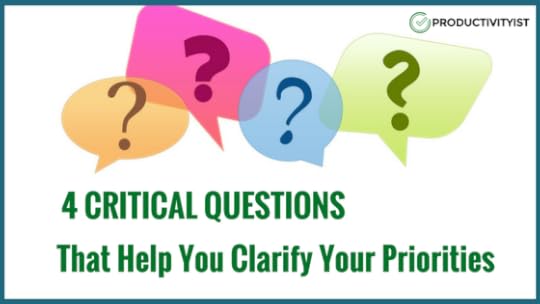
This guest post is by Kent Sanders. Kent is an author, college professor, and host of the Born to Create podcast. He writes about mindset and productivity for creatives at KentSanders.net. You can click here to download a free resource to help you be more productive and creative. You can also connect with Kent on Facebook and Twitter.
The time I spent in grad school was one of the most exciting periods of my life. It was also one of the most dangerous.
Once a week, I would drive about 100 miles to the university where I was taking courses. The early morning drive was fine, but the drive back home at night was a killer. After sitting in class all day, I would get extremely drowsy. On some occasions, I even found myself drifting off of the road.
Drifting is dangerous, whether it’s happening in a car or your creative life.
There are several reasons for drifting: being too busy, feeling overwhelmed, or just plain being tired. Whatever the reasons, the result is the same: less focusing on priorities.
So how can you stop drifting and get back on track? These four questions will help clarify your priorities and refocus on what is most important to you.
1. The question of identity: WHO AM I?
The familiar phrase “Know thyself” is attributed to Socrates (but it actually predates him). Regardless of who said it first, it is a piece of wisdom everyone should follow. If you don’t know who you truly are, you’ll be like a rudderless ship in an ocean of constantly changing priorities.
Knowing yourself well involves both your personality and your skills. When you know how you’re wired and what your skills are (and aren’t), it frees you up to truly be yourself. It also releases you from the obligation of trying to be someone you’re not. It’s much better to work with your personality (and gifts) than against it.
2. The question of mission: WHY AM I HERE?
It may seem like this question more philosophical than practical, but nothing could be more practical than knowing your mission. Then you can make sure your actions are in alignment with your calling.
When you are clear about your mission in life, you have a sense of momentum that keeps you going despite obstacles. It also helps clarify your real priorities from other things that may seem urgent, but are not important in the big picture of life.
3. The question of audience: WHO AM I SERVING?
This question is both very simple and very complicated at the same time. Let me explain.
It’s simple because knowing who you are serving clarifies how you can best serve them. For example, if you’re a web designer, it will not be a high priority for you to write a romance novel (in terms of what is valuable for your customers). However, taking an advanced course on web design should be higher on your priority list.
It’s also a complicated question because it’s difficult to narrow down an audience. But once you are clear on who you’re serving and how you can best help them, how to use your resources should become clearer.
4. The question of productivity: WHAT SHOULD I BE DOING?
After you have gained clarity about your identity, mission, and audience, you must decide on what you should do with your time.
The question, “What should I be doing?” mainly concerns productivity and concerns three areas: your goals, your use of time, and your commitments. You must be clear on these three areas in order to be productive. It’s vital to have a clear handle on how you’re spending your time, and whether you are setting and reaching goals that will produce results for you. It’s also vital that your commitments in life aren’t working against your creative goals.
Each of these four questions can help you stop drifting and help clarify your priorities. I hope you’ll take a few moments to think about each one and whether you can clearly answer them.
The post 4 Critical Questions That Help Clarify Your Priorities appeared first on Productivityist.



